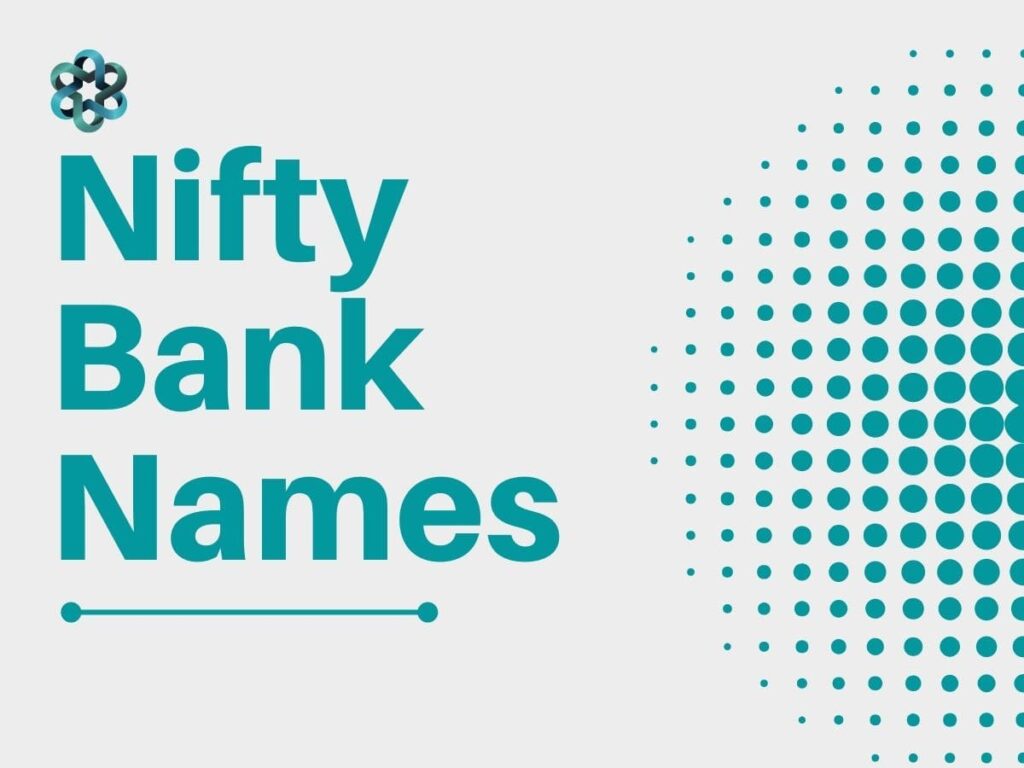Immerse yourself in the world of banking stocks with our insightful list of banks in Bank Nifty, complete with their corresponding weights (this list includes insights into Bank Nifty Weightage Stocks, Nifty Bank Weightage NSE, Bank Nifty Weightage, NSE Bank Nifty Weightage Today, Bank Nifty Banks list, Bank Nifty Components Weightage).
The Nifty Bank Index, akin to Nifty 50 which hosts the top 50 performing stocks, encompasses the leading banking stocks. This select group consists of the top 12 government and private banking institutions, collectively known as Bank Nifty or Nifty Bank.
As one of the most actively traded indices in the futures and options segments, the Nifty Bank delivers a sweeping overview of the entire banking sector’s performance.
To help you navigate the seas of stock investment, we present the Bank Nifty weightage table below. Packed with extensive information about each bank, their market capitalization, and their standing weightage in the Bank Nifty, this resource serves as an essential tool for making informed investment decisions. Explore, analyze, and strategize.

Bank Nifty Weightage | Nifty Bank Weightage
Nifty Bank Names(Constituents) and Bank Weightage
The following data provides a comprehensive list of constituents of the Nifty Bank and their respective weightage. The Nifty Bank Index is a yardstick to measure the performance of the Banking sector within the Indian equity market. It comprises some of the most significant banking stocks listed on the National Stock Exchange (NSE).

Unlike the comprehensive Nifty 50 where banking holds a smaller proportion, this sector-specific index provides a close look at the bare-bones performance of the banking industry. Weightage, on the other hand, is the degree of importance given to an individual constituent in relation to the index as a whole. The weightages are used to calculate the index’s overall performance. The table below captures this unique relationship between various constituents and their weightage within the Nifty Bank index.
Read More : Indian Stock Market
| Bank Name | Bank Weightage |
|---|---|
| HDFC Bank | 28.55% |
| ICICI Bank | 27.96% |
| Kotak Mahindra Bank | 11.50% |
| Axis Bank | 11.36% |
| State Bank of India | 9.28% |
| IndusInd Bank | 4.03% |
| AU Small Finance Bank | 1.62% |
| Bank of Baroda | 1.54% |
| IDFC First Bank | 1.37% |
| Federal Bank | 1.14% |
| Bandhan Bank | 0.90% |
| Punjab National Bank | 0.75% |
The Impact: Top 5 Most Weighted Stocks in the Bank Nifty
The stability and growth of the banking sector in India are closely tied to the performance of the top five most weighted stocks in the Bank Nifty index. Here’s how each of these banks play an influential role:
- HDFC Bank: As the most weighted stock and leading private sector bank, HDFC Bank has been consistently ranked as one of the best managed and most profitable banks in India. Its leading position in the banking sector makes it highly influential on Bank Nifty’s movement. Any fluctuation in its stock prices can significantly affect the overall index, requiring investors to monitor it closely.
- ICICI Bank: Another private sector banking giant, ICICI Bank, impacts the Bank Nifty due to its strong market presence and market capitalization. The bank has remained an essential player in the financial sector, expanding its services to various financial segments like insurance, asset management, and investment banking. As a banking heavyweight, its performance directly affects Bank Nifty’s direction.
- Kotak Mahindra Bank: Established as a non-banking finance company, Kotak Mahindra Bank has grown rapidly to become a major player in the Indian banking sector. It successfully penetrated various financial segments, such as wealth management, insurance, and brokerage services. Its weight on the Bank Nifty index makes it essential for investors to keep an eye on its stock performance.
- Axis Bank: One of India’s top private sector banks, Axis Bank has carved its niche in the banking sector through continuous expansion and the introduction of innovative products and services. Its large customer base and wide network of branches contribute to its significant influence on Bank Nifty’s performance. Any sudden movements in Axis Bank’s stock prices can have an immediate effect on the index.
- State Bank of India (SBI): The largest public sector bank in the country, SBI remains an important contributor to Bank Nifty. SBI’s extensive network and diverse financial services serve a wide section of society, making it a key player in India’s financial ecosystem. Though public sector banks faced numerous challenges in recent years, SBI’s stock performance still carries substantial weight on Bank Nifty’s direction.
The top 5 most weighted stocks in the Bank Nifty index represent the core of the Indian banking sector. Their performance significantly impacts the health of the banking industry as well as investments and market sentiment. Consistent growth and stability in these banks’ stocks contribute to the overall performance of the index, making them vital indicators for investors and policymakers.
Read More : Indian Banking System
“Bank Nifty Firms: Market Capitalization, Free Float, Stock Weightage, and One-Year Performance Analysis”

Below is the table showcasing the Bank Nifty constituents, their market capitalization, free float, stock weightage, and performance over the past year:
| Bank | Market Capitalization (₹ crores) | Free Float | Stock Weightage | Performance Last 1 Year |
|---|---|---|---|---|
| HDFC Bank | 9,18,000 | 74.48% | 28.55% | 22.12% |
| ICICI Bank | 6,70,000 | 99.99% | 27.96% | 24.97% |
| Kotak Mahindra Bank | 3,72,000 | 74.03% | 11.50% | 1.38% |
| Axis Bank | 2,96,000 | 91.85% | 11.36% | 39.99% |
| State Bank of India | 5,23,000 | 42.52% | 9.28% | 19.28% |
| IndusInd Bank | 1,16,000 | 83.52% | 4.03% | 61.68% |
| AU Small Finance Bank | 52,111 | 74.45% | 1.62% | 39.97% |
| Bank of Baroda | 1,03,000 | 36.03% | 1.54% | 83.61% |
| IDFC First Bank | 54,696 | 60.03% | 1.37% | 136.78% |
| Federal Bank | 27,409 | 100.00% | 1.14% | 25.24% |
| Bandhan Bank | 35,737 | 60.01% | 0.90% | -21.21% |
| Punjab National Bank | 66,858 | 26.85% | 0.75% | 94.58% |
Read More : Nifty 50 Weightage
Digging Deeper into the Concept of Bank Nifty Weightage
The Bank Nifty Weightage is a crucial benchmark in India’s stock market. It signifies the weighting distribution or the varying degrees of importance assigned to various bank stocks within the Bank Nifty index, essentially determining the magnitude of the impact each bank has on the overall index’s performance.
The significance of this weightage becomes apparent as it directly sways the trajectory and movement of the stock market. It essentially sets the tone of the market by indicating which stocks are predominantly driving its direction at any particular time.
A bank’s specific weightage in the Bank Nifty index is calculated based on its Free Float Market Capitalization. This calculation takes into account all readily available shares for trading in the market, excluding locked-in shares such as government holdings, promoter holdings, and shares that are otherwise not available for public trading.
By focusing on these ‘free’ shares, the index offers a more accurate reflection of the market scenario and the bank stocks which the general public is actually able to buy or sell. Thus, gaining a solid understanding of Bank Nifty Weightage is key to deciphering market trends and making informed investment decisions.
Read More : Core Banking System (CBS)
Exploring the Composition of Bank Nifty Weightage Stocks
Let’s delve deeper into the elements that make up Bank Nifty stocks. Essentially, these refer to the shares of various banking corporations that collectively form the Bank Nifty index.
The leading stocks within this index wield significant influence due to their hefty weightage, often driving the direction in which the entire Bank Nifty moves. While these weightages offer robust insights into market trends, it’s crucial to bear in mind that they remain subject to fluctuations driven by the respective bank’s current market circumstances.
This underlines the dynamic nature of the stock market, wherein the weightage of stocks in indices like the Bank Nifty is in a constant state of flux, reflecting the ongoing changes in the market environment and the relative performance of the individual constituents.
Nifty Bank Weightage: Examining the Terminology

It’s not uncommon for some individuals to use the terms ‘Nifty Bank Weightage’ and ‘Bank Nifty Weightage’ interchangeably. However, it’s essential to understand that both phrases essentially refer to the same concept. Regardless of whether you encounter ‘Nifty Bank’ or ‘Bank Nifty’, keep in mind that they both denote the same index that has a considerable influence on the Indian stock market.
By clarifying this point, you can ensure that discussions and analyses about the stock market remain consistent and accurate, avoiding potential confusion around the terminology.
Read More : Insurance Wisdom 101
Bank Nifty Stocks Weightage: A Detailed Analysis
A comprehensive understanding of the weightage of individual stocks within the Bank Nifty index is vital for analysing the market dynamics and recognising potential investment opportunities. As individual bank stocks with high weightage can considerably sway the overall index movement, investors need to stay abreast with these changes to steer their investment strategies effectively. With more knowledge of the various Bank Nifty stocks and their respective weightages, investors will be better positioned to navigate their way through the fast-paced world of stock trading.
SBI Weightage in Bank Nifty: A Case Study
The State Bank of India (SBI) is a pivotal player in the calculation of the Bank Nifty index due to its considerable weightage. The financial overall health and performance of the SBI can significantly impact the total performance of the Bank Nifty Index given its prominence.
Elements Influencing SBI’s Weightage
The SBI’s weightage in the Bank Nifty index isn’t an arbitrary figure but rather is determined by several key factors, including:
- Market Capitalization: A dominant determinant of the SBI’s weightage is its market capitalization. The larger the SBI’s market capitalization, the greater its weightage in the index.
- Financial Performance: The SBI’s quarterly results and annual reports considerably sway its weightage in the Bank Nifty index. Positive financial results usually render an increase in the bank’s weightage in the index.
- Economic Developments: Domestic and global economic changes or policies that affect the SBI also cause a shift in its weightage in the index. Changes in interest rates, government regulations, or global economic trends generally end up reflected in the SBI’s weightage.
- Industry Competitiveness: How competitive the SBI is within the banking industry is another vital factor that influences its weightage. The competitiveness is judged by various metrics, including the bank’s market share, customer base, variety of product offerings, and progress in digital growth strategies.
Read More : Real Time Gross Settlement (RTGS)
Implication of SBI’s Weightage on the Bank Nifty Index
The substantial weightage of SBI in the Bank Nifty index suggests that any significant modifications in the bank’s financial performance or market conditions can create a ripple effect on the overall index. A high or low performance from SBI can tilt the Bank Nifty Index, either propelling it upwards or pulling it downwards.
For those invested in the market, it is essential to stay updated about SBI’s performance and its weightage in the Bank Nifty Index. Keeping a close eye on these factors can assist investors and stakeholders in making well-informed decisions about their next moves in the market.
Frequently Asked Questions(FAQs)
What is Bank Nifty?
Bank Nifty, also known as Nifty Bank, is an index comprised of the most liquid and large capitalized Indian Banking sector stocks listed on the National Stock Exchange (NSE). It provides investors with a benchmark that captures the capital market performance of Indian Banks.
How is the weightage in Bank Nifty calculated?
Bank Nifty weightage is based on the free-float market capitalization of the banks included in the Index. The level of the index reflects the total market value of all the stocks in the index relative to a particular base period.
Which banks have the highest weightage in the Bank Nifty?
The banks with the highest weightage in the Bank Nifty are typically HDFC Bank, ICICI Bank, Kotak Mahindra Bank, Axis Bank, and State Bank of India.
How does a bank’s weightage in the Nifty Bank index impact its stock price?
A bank’s weightage in the Nifty Bank index doesn’t directly impact its stock price. However, if a stock has a high weightage, it means the stock heavily influences the index movements. Therefore, any major change in the stock price of heavily weighted banks can significantly impact the overall index performance.
What factors influence the weightage of a stock in Bank Nifty index?
Factors such as the market capitalization of the stock, the free-float factor (i.e., the percentage of shares available for trading), and the overall performance and stability of the bank influence the weightage of a stock in the Bank Nifty index.
Does the weightage of banks in the Bank Nifty change?
Yes, the weightage of banks in the Bank Nifty does change. It is determined based on the free-float market capitalization of the banks, which changes with stock price movements and the quantity of shares available for trading in the market.
How frequently is the Bank Nifty index re-balanced?
The Bank Nifty is re-balanced semi-annually. The index change, if any, is communicated to the market one month before it becomes effective.
How can changes in Nifty Bank’s weightage affect my investments?
Changes in Nifty Bank’s weightage can impact index funds or ETFs that replicate or track the Nifty Bank Index. If a bank’s weightage in the index increases or decreases, the fund or ETF will also increase or decrease its holdings in that bank proportionally.
Risks Involved in Investing in Bank Nifty

Investing in the banking sector, like any other investment, carries potential risks. Let’s break down the specific issues that can arise with respect to the Bank Nifty:
- Market Risk: The banking sector, similar to other sectors, is susceptible to the overall movements and trends in the financial markets. When the broader market is bearish, banking stocks often follow that trend. Market fluctuations can be due to factors beyond your control such as geopolitical events, changes in federal policy, or international transitions in the financial world.
- Interest Rate Risk: Banking stocks and indices, such as the Bank Nifty, can be highly sensitive to changes in interest rates. When the Central Bank hikes interest rates, the profit margins of banks can come under pressure leading to drop in share prices.
- Credit Risk: Banks are exposed to the risk that a borrower will default on any type of debt by failing to make required payments. Any rise in Non-Performing Assets (NPAs) can have a negative impact on the bank’s profits – this might also lead to a fall in the bank’s share price.
- Regulatory Risk: Banking is a highly regulated sector. Any changes in government regulations or laws can have a significant impact on a bank’s profitability and therefore, its stock price. Baseline regulations such as capital adequacy norms, or specific regulatory measures like banning of specific bank charges, could all potentially affect a bank’s bottom line.
- Competitive Risk: The banking industry is evolving rapidly with the emergence of new-age digital banks, FinTech firms, and non-banking financial companies (NBFCs). These competitors are compelling traditional banks to digitize and innovate, potentially creating short-term disruption and long-term uncertainty.
- Economic Risk: As banks are a mirror of an economy’s health, any downturn in the economy can impact bank’s profitability and thereby, the weightage of the banks in the index.
To mitigate these risks, it’s essential to diversify your portfolio, conduct due diligence, and seek professional advice. Investing should always align with your financial goals, risk tolerance levels, and investment horizon. And don’t forget the golden rule of investing: never invest more than you’re willing to lose.
Conclusion: Bank Nifty Weightage | Nifty Bank Weightage
Understanding the weightages of banks within the Nifty Bank Index is a vital part of making well-informed investment decisions in the dynamic field of banking. This knowledge can significantly improve the accuracy of your predictions on market trends and help you decipher the potential influence each bank has on the overall index.
Remember that while HDFC Bank, ICICI Bank, Kotak Mahindra Bank, Axis Bank, and the State Bank of India carry the highest weightages within the index today, these rankings will evolve over time. Factors such as market capitalization, bank performance, and market sentiment can influence each bank’s weightage in the index.
With the rapidly growing digitization trend in the banking sector and drastic innovations in banking technology, the players within the banking landscape will continue to be disrupted. Thus, the weightages within the Index may see shifts based on which banks adapt most successfully to these changes.
Keep in mind that reading the market is as much an art as it is a science. There is always an element of unpredictability. Stay informed, be adaptable, and maintain a keen sense of curiosity. Here’s to your investment journey in the ever-fascinating theatre of the banking sector. Happy investing!
Disclaimer
This article is provided for general informational purposes only and is not intended as financial or investment advice. The content seeks to present accurate information, but it does not consider individual financial circumstances and may not be suitable for all readers. Any views or opinions expressed in the article are the author’s own.
Data such as financial figures and stock values mentioned in the article are accurate at the time of writing and may change without notice. The author and the blog do not guarantee the completeness, reliability or accuracy of this information.
Investment in the banking sector or any other financial market carries a significant risk, including the possibility of loss. Past performance is not indicative of future results. Readers should conduct their own research, consider their financial position, risk tolerance, and possibly seek professional advice before making any investment decisions.
Remember, the value of investments, and any income from them, can fall as well as rise, so you can get back less than you invested.

3 thoughts on “Empowering Bank Nifty Weightage | Influence of Nifty Bank Weightage 2023”